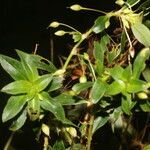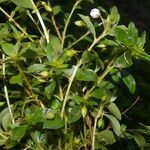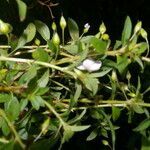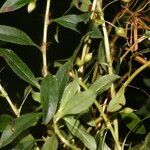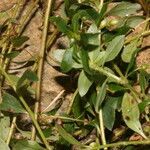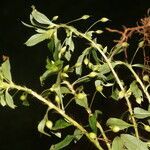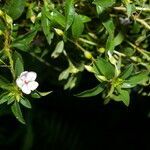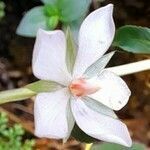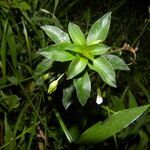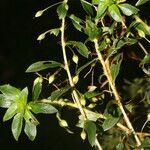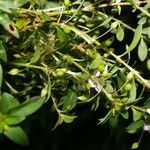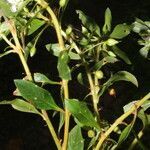Annual or perennial herb, semi-creeping or with erect shoots 5–60 cm tall, often with elongate branches from near the base, glabrous; stems red or purple-tinged, slender, wiry, angular.. Leaves elliptic or oblong-elliptic to oblanceolate, 0.8–3 cm long, 2–9 mm wide, acute to obtuse or shortly apiculate at the apex, narrowed to the base, thickened and serrulate at the margin; petiole usually absent but sometimes up to 4 mm long, slender; stipules linear, 4.5–7 mm long, with long-fimbriate margins.. Flowers axillary, solitary or rarely paired; pedicels purplish, (5–)8–20 mm long, very slender.. Sepals elliptic, 3–7 mm long.. Petals white to pink, obovate, 5–8 mm long, 3–5 mm wide, rounded at apex, spreading.. Outer filiform staminodes numerous in an uninterrupted whorl, crimson or purplish, sometimes white above.. Inner petaloid staminodes white, crimson to purple at the base, oblong-elliptic, 2.5–4.5 mm long, truncate to retuse at apex; anthers yellow, linear-oblong, 1.5–2 mm long.. Ovary ovoid, 1 mm long; style slender, 1.5–2 mm long.. Capsule ovoid, ± 5 mm long; seeds brownish orange, ellipoid or cylindric-ellipsoid, 0.5 mm long.. Fig. 9/1–6 (p. 56).
Leaves narrowed at the base but not usually petiolate; lamina 0·8–3 × 0·2–0·9 cm., elliptic or oblong-elliptic to oblanceolate, acute to obtuse or shortly apiculate at the apex, with margin serrulate and incrassate, narrowed at the base, membranous-papyraceous, with ascending main lateral veins prominent above but not below, and secondary and tertiary venation much less distinct; petiole slender, up to 4 mm. long, or more usually absent; stipules 4·5–7 mm. long, linear, with long-fimbriate margins.
Outer filiform staminodes ? in an uninterrupted whorl, white in upper parts or wholly crimson to purplish, 0·5–1·5 mm. long; inner petaloid staminodes white with crimson to purplish base, 2·5–4·5 mm. long, oblong-elliptic, truncate to retuse or eroded at the apex; stamens with anthers yellow, 1·5–2 mm. long, oblong-linear.
A low growing herb. It grows 60 cm high. The stems are slender and wiry. The leaves are 1-3 cm long by about 0.8 cm wide and taper to the base. The flowers are usually single and in the axil of leaves. The flower petals are pink or white. The fruit is a capsule. It is 5 mm long. The seeds are 0.5 mm long.
Herb, perennial or annual, with erect shoots up to c. 60 cm. high and frequently ± elongate ascending branches from the base, glabrous; stems slender, wiry, angular, green or sometimes reddish towards the base.
Flowers solitary or rarely paired, in axils of foliage leaves; pedicels (5) 8–20 mm. long, very slender, articulated at or up to 2 mm. above the base.
Capsule c. 5 mm. long, ovoid; seeds 0·5 mm. long, cylindric-ellipsoid to ellipsoid, brownish-orange, with punctate testa.
Sepals 3–7 mm. long, narrowly ovate, acute, green with pale margin.
Petals white to pink, 5–8 × 3–5 mm., obovate, rounded, spreading.
Ovary c. 1 mm. long, ovoid; style slender, 1·5–2 mm. long.
